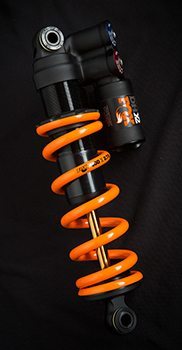
Fox DHX2 Rear Shock
Stroke Length: 3”
Eye to Eye: 9.5”
Blister’s Measured Weight: 435g (w/o spring), 339g (375# SLS Spring)
Total Weight: 774 g
MSRP: $599.99 (w/o spring)
Bolted to: Devinci Wilson Carbon
Rider: 5’9” 155 lbs.
Test Location: Whistler and Fernie, BC; Whitefish, MT; Kellogg, ID
Test Duration: 2 months
Glimpses of Fox’s DHX2 first started appearing last year, and more recently, Fox released the shock with a two-position open / firm lever option. Pretty quickly, the DHX2 moved up in the ranks as one of the most talked about dampers available for DH and Enduro bikes.
With their lineup expanding into air shocks — and now featuring something akin to a climb switch — Fox’s DH-oriented dampers have all the bases covered.
I’ve spent the last two months logging vert on the coil sprung 2017 DHX2 to see if the hype is real…
Options
The DHX2 is available in the normal assortment of sizes to fit pretty much any DH bike on the market, and it’ll fit most of the longer travel Enduro bikes as well. The version with the two position lever is only available on the smaller shock sizes, though. As of this writing, it’s not available in metric sizing, but I’ve seen glimpses of some other metric-sized Fox shocks, so it’d be reasonable to expect metric sizes in the future, as demand from frame manufacturers dictates.
The DHX2 is available with a traditional steel spring, or with Fox’s new SLS (super light steel) spring, which is available in 25 lb increments. I’ve been running a 375 lb SLS spring on my Devinci Wilson, and the spring is significantly lighter than an equivalent steel spring. My 375 lb SLS spring weighs 339 g while a 400 lb Rockshox Vivid spring weighs 627 g. For the ‘Muricans in the audience, that’s about .6 lbs in the spring alone. And for reference, the SLS spring is actually a bit lighter than the listed weight for a Renton Ti spring (and the Ti spring costs about twice as much).

Fox also makes the Float X2, an air shock that utilizes a similar damper to the DHX2. I haven’t spent enough time on the Float X2 to arrive at any final conclusions, but generally speaking, the air shock is lighter, and will be more progressive than the coil DHX2.
The air shock also allows for more tuning options; air pressure can be easily changed, and volume reducers can fine tune how much the shock ramps up toward the end of its travel. That said, for DH purposes, I’m still a fan of the coil — the small bump sensitivity and traction they afford is tough to match, and a bike like my Wilson already has a fairly progressive linkage.
Adjustments
The DHX2, like most DH shocks, has independent high and low speed adjustments for both the compression and rebound damping circuits. Low speed adjustments are made with a 3 mm wrench, and high speed adjustments are made with a 6 mm wrench. Each knob has 23 clicks of adjustment, and included with the shock is a handy little tool that has both wrenches.

The only adjustment lacking on the DHX2 that’s found on some other shocks (including some older Foxes) is a bottom out adjustment, or something to that effect. The bottom out adjustment would usually work by increasing pressure or reducing the volume in the piggyback reservoir. To some extent, the same effect can be accomplished by increasing the high speed compression, so I didn’t find myself missing this adjustment on the DHX2.
The Way Things Work, Fox Damper Edition
Just a quick heads up: a bunch of this section is going over the basics of suspension and damping design. If you already have a good handle on that, you might want to skip ahead.
To a large extent, the DHX2 is a traditional twin tube damper — it’s not breaking into new territory in terms of its general design (a Cane Creek Double Barrel, for example, is fairly similar). There are a few details that are nice additions though, and really, the DHX2 just represents a very solid execution of a proven design.
Let’s start with the piggyback reservoir. In any shock, as the shock compresses, oil is displaced and needs somewhere to go. In a piggyback shock, the piggyback is that place; it holds displaced oil, and it serves to increase total oil volume, which minimizes heat buildup and helps dissipate that heat once it does warm up. Inside the DHX2’s piggyback is a traditional internal floating piston (an IFP), which has oil on one side of it, and compressed gas (most likely nitrogen) on the other side. As the shock compresses and oil is displaced, oil flows into the piggyback and moves the IFP, which in turn compresses the gas behind it. This is a common design, but on lower quality shocks, the IFP can be a source of stickiness
Like most of the better quality DH dampers, the DHX2 has independently adjustable high and low speed damping circuits (both for the compression and rebound). The “high” and “low speed” is referencing shaft speed – the speed that the shock is compressed. Higher shaft speeds generate higher oil pressures, which are handled differently within the shock.
The compression and rebound circuits use what Fox calls RVS, or rod valve system. It uses a needle valve of sorts for the low speed circuits, and a shim backed by a spring for the high speed circuits. The low speed circuits (both for compression and rebound) are fairly straightforward – thread the 3mm adjustment knob in and it threads a “needle” into a hole, which limits oil flow through that hole. That makes the shock feel “stiffer” on the compression circuit, and slower on the rebound circuit.
A gentle roll in the trail will compress the shock slowly, and thus the low speed circuit might primarily be in play. But with higher shaft speeds, like landing a big jump or drop or smacking into a big bump, the oil can’t flow through that little hole fast enough, which means a bunch of pressure builds up. This is where the high speed compression circuit kicks in – when pressure builds, a shim moves out of the way, making for a second, larger orifice for the oil to flow through.
The high speed shim is backed by a spring, so as you thread the 6mm high speed adjustment in, it adds preload to that spring, which means it’s harder for the shim to move out of the way. The DHX2 also is constructed in a way that allows the shim itself to flex and allow oil past, and according to Fox, this helps makes the transition between the low speed circuits and the high speed circuits a bit less severe.
And if none of this is making any sense, here’s a video from Fox that might explain it better:
So, long story short, while Fox isn’t reinventing the wheel with the design of the DHX2, they’ve tweaked it to work better, ride better, and hold up to abuse better. A lot of the most important changes aren’t self evident – it’s little things like the geometry of the seal heads and the materials used to reduce stiction. The most visible example of that is the Ti-Nitride coating on the shock shaft. Ti-Nitride is a low friction, hard wearing coating that’s similar to Fox’s Kashima coating, except it’s even slipperier.
If you really want to geek out on the internal workings of these shocks, check out this video from Vorsprung. He’s comparing the Fox Float X2 to the Cane Creek Double Barrel Air, but a lot of the internal workings of those shocks are very similar to their coil counterparts.
NEXT: The Ride, Durability, Etc.

Nice review. I wish a DHX2 Air would fit in my Remedy.
“Slowing the rebound down a few clicks on both the high speed and low speed circuits helped keep the bike from getting kicked around as much, without leading to the shock packing up.”
IMO, the ability to achieve BOTH of these traits is the holy grail of rear shock design!